A bright comet, the year's best meteor shower, and a total lunar eclipse are coming our way. See the sights and share the news!
A Comet for Christmas (Now through December)
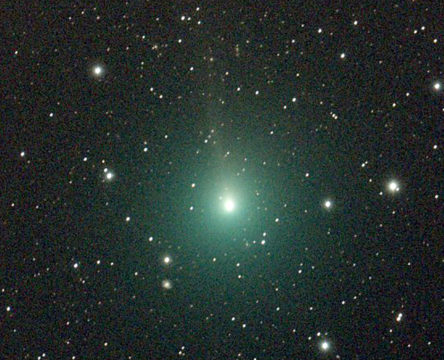
Martin Mobberley
As the year winds down, naked-eye sky events are happily headed in the opposite direction. Three cosmic bonbons will round out 2018 and open the new year. The first is already underway — a fine apparition of periodic comet 46P/Wirtanen.
We'll take it as a good sign that the comet is already visible in binoculars for southern U.S. observers, glowing at around magnitude 7.5 with a plump 20′ (arcminute) coma. It's still rather diffuse with a degree of condensation (DC) of 3. DC is rated on a scale from 0 to 9, where 0 is completely diffuse and uniform and 9 stellar or disk-like.
Because of clouds and commitments, I last saw 46P two weeks ago, when it smoldered in Fornax, the Furnace, at declination –32°. It's still there and slowly climbing north, but has brightened by nearly two magnitudes, leading me to believe the comet's on target to crack the naked-eye barrier by mid-December, when it passes closest to the Earth. I've seen forecasts of magnitude 3, but most of us would be thrilled with even borderline naked-eye visibility. Based on its current performance, it's almost certain to achieve that.
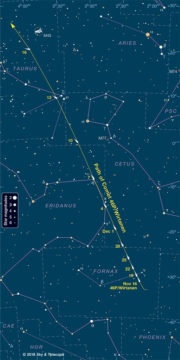
Sky & Telescope
Comet 46P/Wirtanen circles the Sun every 5.4 years. This time around, the comet passes just 11.5 million kilometers or 30 lunar distances from Earth at opposition on December 16th. Since perihelion, its closest approach to the Sun, occurs just four days earlier, we're understandably excited about the comet's prospects. As far as modern comets go — those observed since 1950 — 46P will climb to 10th place on the Earth's Closest Encounters list during this apparition.
Despite its tiny 0.56-kilometer-wide nucleus 46P/Wirtanen belongs to a small group of hyperactive comets that release lots of extra dust and gas than expected for such a small object. We'll count that as another check mark for an optimistic outlook.
The comet remains at a low declination in Fornax through mid-month before hurrying northward, all the while approaching Earth and (hopefully) continuing to brighten. At closest approach, it's beautifully placed in the evening sky between the Pleiades and Hyades star clusters and moving northeast at 4-5° day. I expect more than a few of us will get frozen fingers taking pictures of the amazing scene — bring hand warmers! While observers in the Southern Hemisphere will lose sight of 46P by mid-December, it remains enticingly in view from the Northern Hemisphere into February.
For more on the comet including how to participate in inner coma studies for the 4*P Morphology Campaign, click here.
Gobs of Geminids (December 13–14)
Just as the comet peaks, the Geminid meteor shower momentarily steals the show. This annual spatter of asteroid dust from the rock comet 3200 Phaethon reaches maximum on the night of December 13–14 with up to 100 meteors per hour visible. That number is idealized and based on a perfect sky with the radiant at the zenith. In the real world, you'll probably see closer to one a minute from a reasonably dark sky.
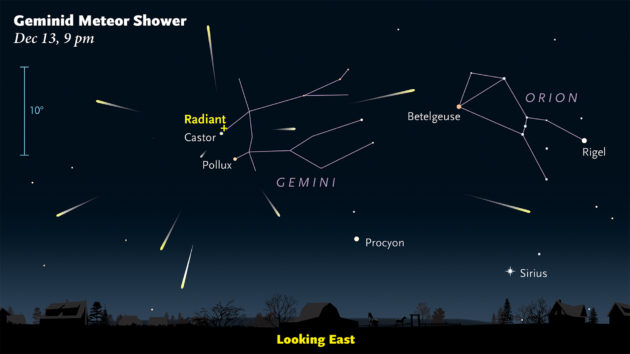
Sky & Telescope / Gregg Dinderman
The best viewing time for most meteor showers is usually in the small hours before dawn. And while that's strictly true for the Geminids, the shower's radiant is already a third of the way up in the eastern sky by 9 p.m. local time. That's why I consider the shower one of the best for family viewing, since you can take the kids out for an hour between 9 and 10 and see up to a dozen or two light streaks.
The only equipment you'll need are reclining chairs, warm clothing, and blankets to snuggle under. I like to face east or south and watch Orion and the winter Milky Way slowly climb out of the tree branches as swift meteors flare across the heavens. Geminids can appear anywhere, but they all originate from the radiant point near the star Castor. Meteors near the radiant leave short trails, while those further away can stretch many degrees across the sky. No matter how many meteors flash before your eyes that Thursday night–Friday morning, being outside under the stars is always time well spent.
Not familiar with the winter constellations? While waiting for Geminids, use a free star-finding app like Star Chart (Android / iPhone) to help you get better acquainted with what's what.
Total Lunar Eclipse (January 20–21, 2019)
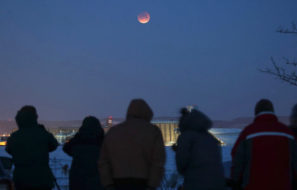
Bob King
After last January's eclipse I'm psyched for the next. It takes place less than a year later on the night of January 20–21 across Europe, Africa, and the Americas. Partial phases begin at 10:34 p.m. Eastern Time (3:34 UT January 21st) with totality lasting from 11:41 p.m. to 12:43 a.m. (4:41 to 5:43 UT). Because the Moon will not pass centrally through Earth's inner shadow or umbra, I suspect this will be a relatively bright totality with the northern third of the lunar disk tinted a colorful orange.
The farther west you live the more convenient the viewing hour. Totality begins at 10:41 p.m. Central Standard Time; 9:41 p.m. Mountain Standard; and 8:41 p.m. Pacific Standard. We'll report in more detail about the eclipse in future stories. For now, it's good to know it's happening whether you plan to observe with friends and family or arrange a sidewalk astronomy eclipse party.
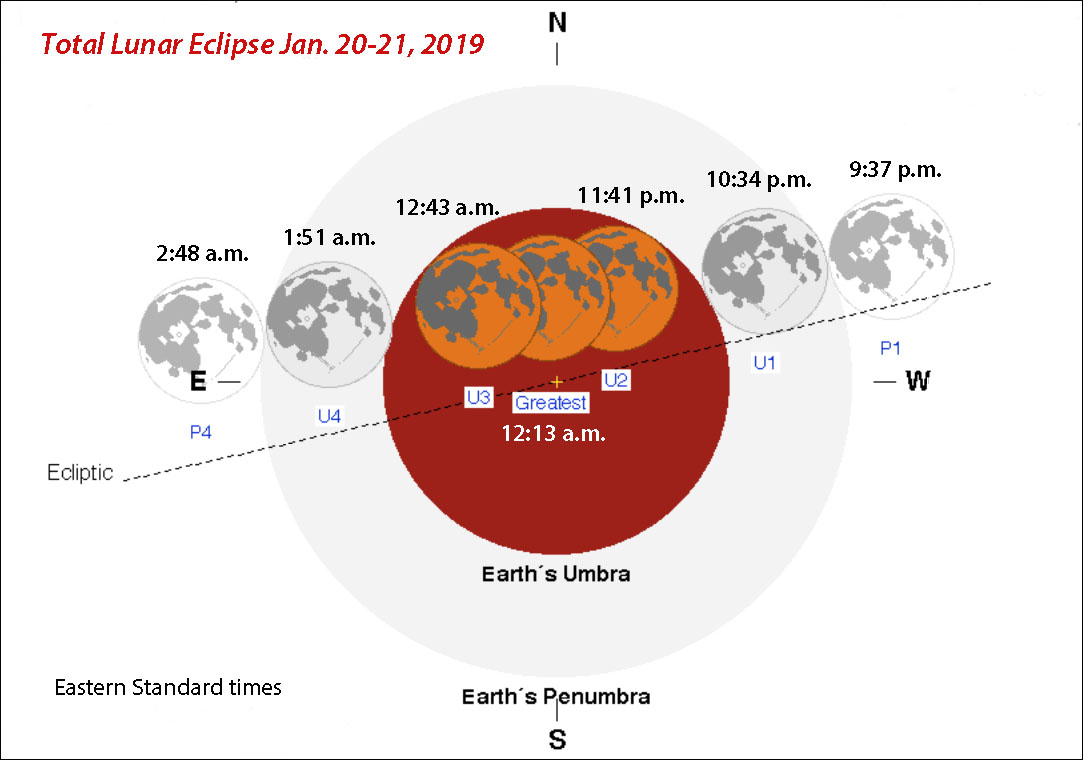
Fred Espenak / NASA / GFSC with additions by the author
All three of these events offer opportunities to show people the great things that go on in the night sky. Best of all, they're visible with just the naked eye or binoculars. Relatable astronomy can fire a lifelong passion for the hobby with newcomers, so share the news!
 13
13








Comments
Rod
November 7, 2018 at 2:53 pm
Bob, good report. I note here "46P/Wirtanen. We'll take it as a good sign that the comet is already visible in binoculars for southern U.S. observers, glowing at around magnitude 7.5 with a plump 20′ (arcminute) coma." I was wondering if this comet had much of a tail, close to 1/3 degree apparently. Nov-16 thru early December according to the chart, I will try and view using my 90-mm refractor and 10-inch Newtonian. From my location in Maryland, looks like 2200-2300 local time could be good, the comet may be 20-30 degrees altitude and in the south sky. First Quarter Moon is 15-Nov and Full Moon 23-Nov so the Moon will compete with comet views 🙂
You must be logged in to post a comment.
Bob KingPost Author
November 7, 2018 at 3:11 pm
Thanks, Rod. No tail has been reported visually — just a substantial coma.
You must be logged in to post a comment.
Rod
November 7, 2018 at 3:22 pm
Bob, thanks for correction, tail vs. coma. I observed comet 21P/Giacobini-Zinner on 04-Sep-18 in Auriga using my 90-mm refractor at 31x, no problem seeing the comet near mv +7. Do you know how 46P/Wirtanen compares here with 21P?
You must be logged in to post a comment.
Bob KingPost Author
November 7, 2018 at 5:14 pm
Rod,
Wirtanen is very fluffy and at this point, not very condensed. It has really nice "glowy" look to it and enhances with a Swan Band filter.
You must be logged in to post a comment.
Tom-Reiland
November 8, 2018 at 3:51 am
This is the 3rd apparition of Wirtanen that I have successfully been able to locate it. 1991 and 1997 were the other years. My observing location at Wagman Obs has a light polluted Southern sky because of some small cities and burgs. I decided to give it a shot anyway, even though it was less than 20 degrees above the horizon. I used a chart with more stars plotted on than yours, however it was off by almost a degree for this morning's position. Fortunately, I scanned North of the position he had shown. I used a light pollution filter and a Swan Band Filter to help locate it. I'm not going to estimate its brightness, but the nucleus and a very small portion of the Coma could be seen. I look forward to seeing it in December when it will be further North and, hopefully, an easy binocular object or even naked-eye.
You must be logged in to post a comment.
Bob KingPost Author
November 8, 2018 at 9:39 am
Tom,
All of us mid-northern latitude types can't wait for the comet to launch out of Fornax into darker skies. I'm very curious if it's going to show much of a tail or if will be a blob comet like 45P/H-M-P in the morning sky in 2017.
You must be logged in to post a comment.
Zubenelgenubi 61
November 8, 2018 at 4:54 pm
46P will be very close to Earth and will no doubt look like a very large fuzzball near its peak. It will probably be rather easy to the unaided eye from very dark sites in mid December if you know the sky but not fare well at all from cities. The predicted peak magnitude of 3 or 4 may actually be achieved based upon observational reports, but refers to TOTAL brightness, not per area. Best views will be in binoculars or low power/wide field telescopes. I wouldn't expect much of a tail based upon past experience, but you never know.
You must be logged in to post a comment.
Zubenelgenubi 61
November 8, 2018 at 4:56 pm
Great imaging possibilities when near the Pleiades around December 16, after the Moon sets.
You must be logged in to post a comment.
ken.starsabove
November 9, 2018 at 1:23 pm
In the caption, you've listed "Jan 31, 2019 Lunar eclipse. Please revise.
You must be logged in to post a comment.
Bob KingPost Author
November 9, 2018 at 1:47 pm
Hi Ken, that's really weird. I was sure I'd written "20." Thanks for pointing it out -- it's now corrected 🙂
You must be logged in to post a comment.
Comet46PWirtanen
November 9, 2018 at 2:14 pm
Visit the Comet 46P/Wirtanen Facebook page: https://www.facebook.com/46PWirtanen/
You must be logged in to post a comment.
Oskie
November 13, 2018 at 3:38 am
Good Day, I am in Botswana, Southern Africa, we have beautiful night skies is the comet visible for us and at approximately what times.
You must be logged in to post a comment.
Bob KingPost Author
November 13, 2018 at 9:53 am
Dear Oskie,
You can see the comet from Botswana high up in the southeastern sky from the time it gets dark until 2 a.m. at least. In the evening, the Moon is starting to add some light so later is better right now. The farther the Moon is from the comet the better. 46P is located in Fornax, a constellation with no bright stars. That makes it a little tricky to find right now unless you know the constellations well. You can use the stars of Cetus to point you there. As the comet moves north, it will pass near some brighter stars and be easier to find and brighter. Right now, it looks like a smudgy spot in small telescopes. No tail yet that will show in a typical telescope.
You must be logged in to post a comment.
You must be logged in to post a comment.